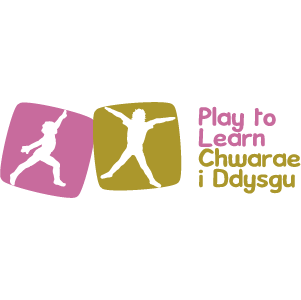
Instructions
Galloping is a continuous locomotor movement performed in a forwards or sideways direction. It uses an asymmetrical gait with the same foot leading on each step. Galloping features in various playground games and some traditional dances.
- Feet face the direction of travel
- Step forwards onto the leading foot and push upwards
- Bring the left foot behind the right foot and vice versa
- The toe of the back foot ‘creeps’ towards the heel of the front foot
- Keep the feet light on landing
- Relax the arms with movement
- Move in a continuous rhythmical action

Safety
Ensure…
- children land on their toes and not their heels children keep heads up and look around when performing
Opportunity to develop
- Co-ordination
- Motor skills
- Control
Physical Development Area of Learning
- contributes to ‘Personal’ and ‘Adventurous and physical play’ skills sections
If you see
| Observation | Likely Cause | Solution |
|---|---|---|
| Deliberate step-hop action | Consciously thinking about the movement | Take smaller steps and faster steps. Back leg should always be ‘trying to catch up’. |
| Trail leg crosses in front of the lead leg during the flight phase | Confuses the movement with a skip. The gallop always leads with a dominant foot. | Move across the space with either the left or right leg leading. Front toe of the back foot moves towards the heel of the front foot. Front foot steps, back foot catches up. |
| Vertical movement of the hop phase is exaggerated | Concentrates on the step–leap phase and does not co-ordinate the arm movements. Arms will give greater horizontal drive. | Step forward on front foot and then bring the arms forward and clap. Arms then drive back as back foot catches up. Use some music to develop rhythm. |
Can you see?
- the child demonstrating rhythmical movement?
- the child transferring weight from one foot to the next?
- the child demonstrating low vertical lift on the flight phase of the movement?
- the child pushing off and landing on the balls of feet on each step?
- the child’s toes of the back leg ‘creeping’ towards the heel of the front leg?
- the child galloping – leading with either leg?
-
Mostly No
- On the spot, use a tambourine to hear and feel the rhythm of the gallop.
- Step forward with the front foot and the trail leg to ‘creep’ or ‘drag’ up to the heel of the front foot. Rise up onto the balls of each foot.
- Walk along a line or narrow corridor of cones with one foot leading and the other foot trailing. Encourage a step onto the front foot and then ‘drag’ or ‘pull’ the back leg action.
- Introduce a theme of trains, or music with a constant rhythm. Practise driving both arms forwards and backwards on the spot as the wheels of a train would go round. Ask if they can do this walking/travelling around the room.
- Walk across the room taking small and large steps, leading with the same foot.
-
Yes and No
- Try to co-ordinate the arm movement with each forward step. When stepping forward with the front foot, both arms go forwards together and the arms go back as the back foot contacts the floor. Lead with one foot at a time.
- Move around in a circle side galloping.
-
Mostly Yes
- Gallop with one foot leading, then the other
- Gallop demonstrating changes of direction
- Gallop demonstrating changes of speed – slow, fast, acceleration and through an obstacle course
-
Challenge
- Gallop in different directions and at different speeds, then in response to a range of cues
- Gallop to music / regular beat
- Gallop following a figure of 8, W, M, square, slalom pathway
- Combine leaping, galloping and skipping in response to a range of cues, using different directions, pathways and speeds


